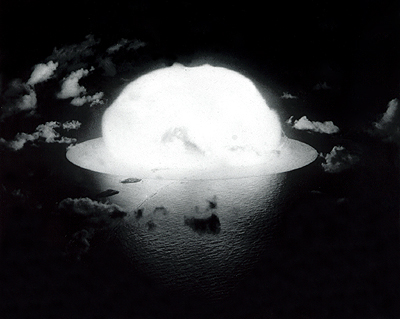Operation Greenhouse

Dog Test observers on Parry Island, Enewetak
The Dog and Easy tests were what was referred to as ‘proof’ tests of two possible strategic weapons, the Mk 6 and Mk 5 respectively. All the shots in this series are tower-mounted. The most iconic image to come out of Operation Greenhouse and, some would say, all atomic tests doesn’t show a mushroom cloud at all but instead reveals rows of VIP observers at the Officers Club on Parry Island, seated in Adirondack chairs and wearing dark goggles. Few people actually know the location. Dog is the highest yield weapon yet tested but was rapidly outdone by George, just a month later. Dog would lift a quarter of a million tons of earth into the stratosphere. It had an improved version of the same Fat Man implosion system but with more detonation points, enabling a more uniform pressure wave. Easy
more uniform pressure wave. Easy
Easy would mark a new design, still an implosion device but with a huge decrease in weight; at less than 3000 lb this device could be pressed into a number of roles. It was a third the weight and half the size of earlier designs. It became the primary for the Ivy Mike ‘Sausage’, the first genuine thermonuclear device. Easy did double duty as an effects test against structures erected on Enjebi for the purpose, like homes, factories, and a concrete bunker.
The first blast in May, code-named George and detonated from a tower on Eniwetok, proved to be a crucial building block for achieving the H-bomb. “Without such a test no one of us could have had the confidence to proceed further along speculations, inventions, and the difficult choice of the most promising possibility,” Edward Teller later wrote.
In the process, thousands more American servicemen were exposed to atomic-fission products from nearby explosions. They too would run afoul of the VA’s reflexive claims denial apparatus in the years to come, as they fell sick and died.
 George
George
George was a totally new, and very odd torus design; shaped like a doughnut, it didn’t look like any other weapon yet tested. The device took the form of a disk, 8 ft in diameter and 2 ft thick with a hole in the center. In the hole, a cryogenic chamber was mounted containing liquid deuterium and tritium, the fusion fuel. This was not a pure fusion weapon but a staged thermonuclear test which inched closer to the goal of fusion through radiation implosion, that Edward Teller and Stanislaw Ulam had in mind. George validated the principles which would lead to the first full-scale thermonuclear bomb test, Ivy Mike, one year later. The majority of its yield still came from fission, not fusion. The blast, rated at 225 kilotons, was the most powerful test yet and left a crater almost 1200 ft in diameter but just 10 ft deep as shallow craters typically resulted from tower-mounted tests.

Item was a hybrid device, a boosted fission bomb fed with deuterium/tritium gas at the moment of detonation, yielding a 45.5 kiloton explosion. This was about double the yield a non-boosted device would have had, more than twice the explosivity of those dropped on Hiroshima and Nagasaki. The injection of a flood of neutrons from the deuterium’s fusion greatly boosted the fission reaction. Item was never considered a viable weapon, but strictly a ‘what if’, to test principles. Any weapon that included cryogenic elements were, by necessity, more costly and larger, making them eminently less practical as weapons.
Series :
Dog – April 7, 1951 (81 kilotons) – Runit, Enewetak
Easy – April 20, 1951 (47 kilotons) – Enjebi, Enewetak
George – May 8, 1951 (225 kilotons) – Ebiriru, Enewetak
Item – May 24, 1951 (45.5 kilotons) – Enjebi, Enewetak
